Continuing to zag when it comes to quarterback development and roster construction, the Packers centered their offseason around a Jordan Love commitment. After seeing a promising second half from their Aaron Rodgers successor nearly produce a voyage to the NFC championship game, the Pack are back in the franchise-QB payment business.
Love’s monster extension complements an offense that lost two of its veteran pillars — in Aaron Jones and David Bakhtiari — as the team continues to build around lofty investments on the defensive side. But the Packers’ Love decision, which is certainly a different route when it comes to an experience-to-dollars ratio, will define the franchise for the foreseeable future.
Extensions and restructures:
- Agreed to terms with QB Jordan Love on four-year, $220MM extension ($100.8MM guaranteed)
- Reached agreement on three-year, $64MM extension ($17.5MM guaranteed) with DT Kenny Clark
- Restructured contracts of DEs Rashan Gary, Preston Smith to create $7MM-plus in cap space
- Reduced OL Royce Newman‘s fourth-year salary by nearly $2MM
When Rodgers agreed to his first extension during his 2008 starter debut season — a six-year, $63.52MM deal, illustrating where QB contracts have gone — it did not check in as a record-setting payday. It was not particularly close, either. Carson Palmer‘s Bengals extension outflanked Rodgers’ first Packers deal. So did Peyton Manning‘s 2004 Colts payday, along with Tom Brady‘s first Patriots re-up and Ben Roethlisberger‘s initial Steelers extension. That gave the Packers a runway to better learn about Rodgers’ capabilities. The organization was certainly proven right and suddenly had a bargain deal at quarterback until the 2013 offseason.
 Today’s skyrocketing QB market changed the equation for Love and the team, which needed to match an NFL-record AAV for a player with 18 regular-season starts. This era of one-upping differs from how a few teams handled QB contracts even following Rodgers’ 2013 extension. No one topped the Packer QB’s $22MM-per-year deal until the 2016 offseason. A host of deals in 2015 (for Roethlisberger, Wilson, Cam Newton, Eli Manning and Philip Rivers) settled between $20MM and $21.9MM per year, acknowledging Rodgers’ place in the game. For the most part, these sort of acknowledgments no longer exist.
Today’s skyrocketing QB market changed the equation for Love and the team, which needed to match an NFL-record AAV for a player with 18 regular-season starts. This era of one-upping differs from how a few teams handled QB contracts even following Rodgers’ 2013 extension. No one topped the Packer QB’s $22MM-per-year deal until the 2016 offseason. A host of deals in 2015 (for Roethlisberger, Wilson, Cam Newton, Eli Manning and Philip Rivers) settled between $20MM and $21.9MM per year, acknowledging Rodgers’ place in the game. For the most part, these sort of acknowledgments no longer exist.
Love’s deal not coming with a discount keeps the Packers in the high-cost QB business, as 2023 — which featured near-record-tying (pre-Russell Wilson, at least) dead money from the Rodgers trade — did not bring a reprieve. Diving right back into a top-market contract, as Rodgers’ deal came off the books this year, ramps up the pressure for Brian Gutekunst and Co. to be right on the player they traded up for in 2020.
Both parties wanted this deal done by training camp, and Love held in to complete the process. The Packers agreeing to a half-measure extension, rather than pick up a fully guaranteed fifth-year option on a player who entered 2023 with one career start, provided Love leverage. The QB capitalized, joining Tua Tagovailoa in this regard, on his contract-year status. The Packers would have faced a $40MM-plus 2025 cap hold had Love played out this season and brought the threat of a franchise tag. Whereas teams have held more control during this process by extending a first-round quarterback after his third season, Green Bay’s outlier three-year apprenticeship program did not give the team that option. After a promising close to last season, Love was able to exert more control in this process.
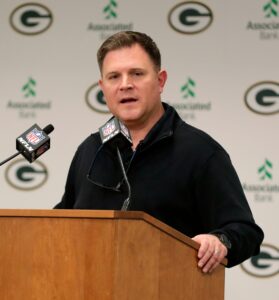 Struggling during much of the season’s first half, Love led the NFL in QBR from Weeks 11-18 — a stretch that included 18 TD passes and one INT. The four-year veteran was then tremendous in the Packers’ wild-card upset over the Cowboys, before leading the NFC’s first competitive No. 7 seed to a narrow loss over the eventual NFC champion 49ers. Love obviously made for an atypical extension candidate, but the Packers are all in.
Struggling during much of the season’s first half, Love led the NFL in QBR from Weeks 11-18 — a stretch that included 18 TD passes and one INT. The four-year veteran was then tremendous in the Packers’ wild-card upset over the Cowboys, before leading the NFC’s first competitive No. 7 seed to a narrow loss over the eventual NFC champion 49ers. Love obviously made for an atypical extension candidate, but the Packers are all in.
Contract structure was believed to be the final issue for Love’s camp. A team that does not do post-Year 1 guarantees beyond signing bonuses again bent for a quarterback, and Love secured the increasingly popular rolling guarantee structure on this deal.
Love’s 2025 salary is guaranteed at signing, and his 2026 base salary is partially guaranteed already. That 2026 figure will become fully guaranteed in 2025. That structure pertains to Love’s 2027 base salary as well. The team guaranteed $20MM of the QB’s ’27 base ($41.9MM) for injury at signing; that $20MM shifts to a full guarantee a year early. Love did remarkably well on this contract and will be positioned, should his late-season form be indicative of his career trajectory, to cash in again before age 30.
 The Packers took care of Clark before his contract year, bringing up an extension earlier this offseason and completing the agreement before training camp. Despite coming into the league in 2016, Clark will not turn 29 until October. The Pack should have more prime years coming from the former first-round pick — one of six first-rounders still on Green Bay’s defense — and they completed a deal without going into the top 10 on a swiftly rising D-tackle market. Clark’s $21.33MM AAV both marked a notable raise and the 11th-highest-paid DT accord.
The Packers took care of Clark before his contract year, bringing up an extension earlier this offseason and completing the agreement before training camp. Despite coming into the league in 2016, Clark will not turn 29 until October. The Pack should have more prime years coming from the former first-round pick — one of six first-rounders still on Green Bay’s defense — and they completed a deal without going into the top 10 on a swiftly rising D-tackle market. Clark’s $21.33MM AAV both marked a notable raise and the 11th-highest-paid DT accord.
Keeping with the Pack’s non-QB standard, the only guaranteed money in Clark’s deal comes from his signing bonus. But the eighth-year DT is owed a $7.5MM roster bonus next March. That ups the practical guarantee to $25MM. It would cost the Packers $17MM in dead money to move on from Clark in 2026, due to signing bonus proration. This gives the veteran a good chance of staying on this through-2027 deal for at least three seasons. Clark is due an $11MM roster bonus in 2026.
The UCLA alum ranks seventh in starts (109) by a Packer D-lineman. He can move into first all time on this contract; Dave Hanner (1953-64) holds that mark at 141.
Free agency additions:
- Xavier McKinney, S. Four years, $67MM ($23MM guaranteed)
- Josh Jacobs, RB. Four years, $48MM ($12.5MM guaranteed)
- Greg Joseph, K. One year, $1.29MM
- Andre Dillard, T. One year, $1.13MM
- Jacob Eason, QB. One year, $985K
Although Hard Knocks primarily focused on the Giants’ Saquon Barkley loss, it also revealed surprise on Giants GM Joe Schoen‘s part upon learning McKinney’s contract.After factoring in a McKinney extension upon letting Julian Love walk in 2023, the Giants did not keep him off the market for the transition tag sum ($13.8MM). That may have been a mistake. The former second-round pick proceeded to score a top-four safety contract, with the Packers paying up to address an issue.
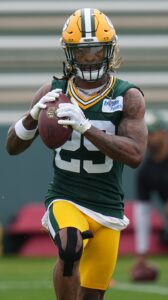 Green Bay moved on from its top three safeties last year (Darnell Savage. Jonathan Owens, Rudy Ford) and paid McKinney, who submitted two quality Giants seasons and two injury-plagued years. After a McKinney ATV accident led to him missing much of the 2022 campaign, Pro Football Focus graded him as the No. 4 overall safety last season. McKinney, 26, represents an out-of-character move from the Packers, who are not known for paying safeties or signing off on — even in the Gutekunst era — top-market free agency accords.
Green Bay moved on from its top three safeties last year (Darnell Savage. Jonathan Owens, Rudy Ford) and paid McKinney, who submitted two quality Giants seasons and two injury-plagued years. After a McKinney ATV accident led to him missing much of the 2022 campaign, Pro Football Focus graded him as the No. 4 overall safety last season. McKinney, 26, represents an out-of-character move from the Packers, who are not known for paying safeties or signing off on — even in the Gutekunst era — top-market free agency accords.
McKinney played the Jessie Bates role on this year’s market. As another macro safety evaluation appeared to take place this year — leading to the releases of several prominent veterans and a slew of mid-market payments for unrestricted free agents — McKinney’s price came in nearly $8MM higher (in terms of AAV) than any other UFA safety. After Bates (four years, $64MM) rewarded the Falcons for their high-cost addition, the Packers won a bidding war for McKinney, who has also shown quality ball skills in his career. The Alabama alum intercepted five passes in 2021 and three last season. Referring to himself as the game’s best safety, McKinney will attempt to prove it in Wisconsin.
Perhaps the most notable participant on a historically busy day at the running back position, the Packers said goodbye to a seven-year regular (Aaron Jones) and brought in Jacobs. The five-year Raiders starter is three years younger than Jones, and while the former has not proven as dynamic, the incumbent approaching his 30th birthday undoubtedly played into Green Bay’s thinking here. Jacobs, 26, won the 2022 rushing title but is coming off a far less productive year on the franchise tag. The Packers will bet on more prime years remaining for Jacobs, who was part of last year’s famous RB macro evaluation.
 The Raiders, Giants and Cowboys respectively not extending their tagged running backs — after the Packers had given Jones a pay cut and the Cowboys (Ezekiel Elliott) and Vikings (Dalvin Cook) had released longtime starters — prompted a Zoom meeting among key backs about their state of the union. Jacobs, who rampaged for an NFL-high 2,053 scrimmage yards and 12 touchdowns in 2022, accumulated only 1,101 last season — before missing four games due to multiple contusions. After producing the fifth-most rushing yards over expected in 2022 (158), Jacobs finished with the fifth-worst number (minus-86) last year.
The Raiders, Giants and Cowboys respectively not extending their tagged running backs — after the Packers had given Jones a pay cut and the Cowboys (Ezekiel Elliott) and Vikings (Dalvin Cook) had released longtime starters — prompted a Zoom meeting among key backs about their state of the union. Jacobs, who rampaged for an NFL-high 2,053 scrimmage yards and 12 touchdowns in 2022, accumulated only 1,101 last season — before missing four games due to multiple contusions. After producing the fifth-most rushing yards over expected in 2022 (158), Jacobs finished with the fifth-worst number (minus-86) last year.
Matt LaFleur admitted he was caught off-guard by how the Packers’ running back situation shook out, and Jacobs also indicated he turned down more money elsewhere. More pass-game opportunities should be expected to emerge for Jacobs, who did catch 107 combined passes from 2021-22.
Green Bay’s Jones-to-Jacobs transition is also interesting due to the younger back having more career touches (1,502) compared to Jones (1,449). Jacobs has missed 10 career games; since 2019, Jones has also missed 10. Six of those came last season. While the Packers guaranteed Jacobs just $12.5MM, he is due a $5.93MM signing bonus if on Green Bay’s roster on Day 5 of the 2025 league year.
This profiles as a two-year deal before a year-to-year scenario takes shape in 2026. Even if Jacobs’ 2025 roster bonus is included, he still fetched far less in fully guaranteed money than Barkley, who secured $26MM from the Eagles despite a well-documented injury history and a higher touch total.
Re-signings:
- Keisean Nixon, CB. Three years, $18MM ($6.5MM guaranteed)
- Corey Ballentine, CB. One year, $2.1MM ($500K guaranteed)
- AJ Dillon, RB. One year, $2.74MM ($168K guaranteed)
- Eric Wilson, LB. One year, $1.38MM ($168K guaranteed)
- Robert Rochell, CB. One year, $1.1MM
Adding slot cornerback to his duties along with return specialist, Nixon scored a solid veteran deal two years after following Rich Bisaccia from Las Vegas. The Raiders nontendered Nixon as an RFA in 2022, leading to Bisaccia’s new team reaching out. Nixon mostly focused on a return-game role in 2022; he blazed to first-team All-Pro status as a kick returner. Nixon repeated that feat in 2023, and the Packers re-signed him just before the NFL radically revamped its kickoff setup. That change stands to make Nixon more valuable.
 Of course, Nixon receiving a $6MM-per-year deal was also contingent on him continuing as the team’s slot corner. The Packers abandoned their Rasul Douglas slot experiment during the 2022 season and went into last year with Nixon in that role. He played 937 defensive snaps — by far a career high — and while PFF graded him outside the top 80 and Pro-Football-Reference’s coverage metrics applied higher numbers in terms of completion percentage (77.8%) and passer rating (104.8), the Packers clearly value the former UDFA in a cornerback group that features little certainty beyond Jaire Alexander.
Of course, Nixon receiving a $6MM-per-year deal was also contingent on him continuing as the team’s slot corner. The Packers abandoned their Rasul Douglas slot experiment during the 2022 season and went into last year with Nixon in that role. He played 937 defensive snaps — by far a career high — and while PFF graded him outside the top 80 and Pro-Football-Reference’s coverage metrics applied higher numbers in terms of completion percentage (77.8%) and passer rating (104.8), the Packers clearly value the former UDFA in a cornerback group that features little certainty beyond Jaire Alexander.
Dillon did not do nearly as well in free agency. On a crowded RB market, the inside grinder settled for a deal that provided next to no guaranteed money. Jones’ powerful complementary option for four seasons, Dillon averaged a career-worst 3.4 yards per carry last year — his first under 4.1 per tote.
The former second-round pick has been effective in the past, and while he said a bit more money may have been out there for him, the Green Bay aficionado — Dillon plans to camp in the city following his NFL career — entered training camp on the roster bubble.
Notable losses:
- David Bakhtiari, LT (released)
- De’Vondre Campbell, LB (post-June 1 cut)
- Josiah Deguara, FB
- Rudy Ford, S
- Aaron Jones, RB (released)
- Yosh Nijman, OL
- Jonathan Owens, RB
- Jon Runyan Jr., G
- Darnell Savage, S
- Patrick Taylor, RB
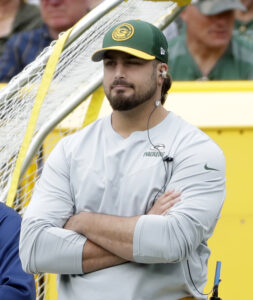 As Shaq Barrett and Jason Pierre-Paul ran wild during the 2020 NFC championship game, Bakhtiari’s absence created one of the bigger what-ifs in offensive line history. The Packers saw an ACL tear sustained during a New Year’s Eve practice change their left tackle course, as Bakhtiari — a first-team All-Pro that season and a five-time All-Pro over his career — has been unable to stay healthy since.
As Shaq Barrett and Jason Pierre-Paul ran wild during the 2020 NFC championship game, Bakhtiari’s absence created one of the bigger what-ifs in offensive line history. The Packers saw an ACL tear sustained during a New Year’s Eve practice change their left tackle course, as Bakhtiari — a first-team All-Pro that season and a five-time All-Pro over his career — has been unable to stay healthy since.
The stalwart LT missed all but 27 snaps in 2021, returning to the sideline after debuting in a meaningless Week 18 game, and — after showing promising form in 11 games back in 2022 — missed almost all of last season. This all pointed to a 2024 separation.
Green Bay had restructured Bakhtiari’s deal in 2021 and ’22, immediately seeing the four-year, $92MM extension — only Rodgers and Love have signed more lucrative deals among Packers — become an issue quickly due to the once-dependable LT signing it weeks before his knee injury. Bakhtiari, who has undergone five knee surgeries since that fateful practice, will count $18.15MM in dead money this year. Like Rodgers’ dead cap hit in 2023, Bakhtiari’s contract will be off the team’s books for good after a year. The 11-year veteran, 33 in September, wants to keep playing but has not caught on anywhere.
Post-Ahman Green, Packers RB1s had been one-contract players. Ryan Grant and Eddie Lacy did not see second contracts, and the team’s rushing attack had bottomed out by the mid-2010s. Enter Jones and Jamaal Williams. The Packers continued their one-contract RB stretch with Williams, but Jones became a priority. Green Bay gave its lead back a four-year, $48MM deal shortly after a host of extensions — for fellow 2017 draftees Christian McCaffrey, Alvin Kamara, Dalvin Cook and Joe Mixon — set the market. A former fifth-round pick, Jones rewarded the team by running his 1,000-yard season count to three and being one of the NFL’s most well-rounded backs.
 Jones powered a Packers offense flooded with rookie contracts to the playoffs, zooming to five straight 100-yard rushing performances to close out last season. Jones showing vintage form during that stretch somewhat obscured his missing six games due to multiple injuries early that season.
Jones powered a Packers offense flooded with rookie contracts to the playoffs, zooming to five straight 100-yard rushing performances to close out last season. Jones showing vintage form during that stretch somewhat obscured his missing six games due to multiple injuries early that season.
The Packers gave Jones a $5MM pay cut in exchange for 2023 guarantees last year, with that transaction coming first during a wave of developments that impacted the RB position’s value. Gutekunst said at the Combine he expected Jones back, but that ended up being contingent on the accomplished vet taking a bigger pay cut. Jones balked, being released shortly before the Jacobs signing commenced.
This closed out one of the better skill-position partnerships in modern Packers history. Jones was easily the best running back of the Rodgers era, and his 2023 work gave Love a solid starter onramp. The Vikings observed this firsthand and quickly signed the eighth-year vet to a one-year, $7MM deal. Jones is expected to be the clear starter in Minnesota, which is making a midlevel bet on another 2017 draftee a year after deeming Cook too expensive. The Packers having conserved Jones — as Williams and Dillon operated as regular 1-B options — may extend his career, and their rivals will count on the UTEP alum having one more quality season in him.
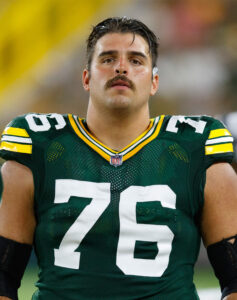 With Elgton Jenkins one of the NFL’s highest-paid guards, the Packers were never expected to offer much competition in the Runyan market. One of five guard FAs who commanded an eight-figure-per-year salary (from the Giants), the second-generation NFL blocker leaves Green Bay after three starter seasons. A former sixth-round find, Runyan started at both left and right guard in Green Bay. He ranked 17th among interior O-linemen in pass block win rate last season.
With Elgton Jenkins one of the NFL’s highest-paid guards, the Packers were never expected to offer much competition in the Runyan market. One of five guard FAs who commanded an eight-figure-per-year salary (from the Giants), the second-generation NFL blocker leaves Green Bay after three starter seasons. A former sixth-round find, Runyan started at both left and right guard in Green Bay. He ranked 17th among interior O-linemen in pass block win rate last season.
Savage’s Jacksonville defection leaves the Green Bay defense with only six first-round picks. How will it survive? Savage’s stock eventually placed him on the expanding middle tier at the safety position, becoming one of the many non-Bates/McKinney safeties to land a deal between $6-$9MM per year over the past two offseasons. While Savage showed versatility by contributing in the slot, he also lost snaps during a down 2022 season. Viewing the 2019 first-rounder as above average in coverage and elite against the run last season, PFF ranked him 15th among safeties.
The Packers still viewed a big upgrade as a priority, letting Savage, Owens and Ford walk and paying up for McKinney. Due to the Packers restructuring Savage’s rookie deal, they will carry more than $5MM in dead money by not re-signing him.
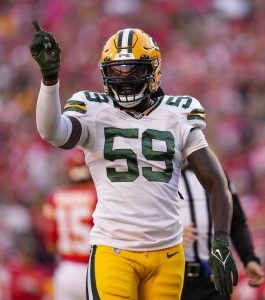 Campbell stabilized his career in Green Bay, coming over after a one-and-done Arizona season generated minimal interest as a 2021 free agent. After a first-team All-Pro 2021 season — when he provided a significant boost to an injury-riddled Packers team — Campbell rocketed back to relevance and scored a five-year, $50MM pact. The Packers were never expected to roster Campbell for the duration of that lengthy accord, and they cut ties with him two years into it. The three remaining years of signing bonus proration will will tag the Pack with $3.7MM in dead money this year and $7.9MM in 2025.
Campbell stabilized his career in Green Bay, coming over after a one-and-done Arizona season generated minimal interest as a 2021 free agent. After a first-team All-Pro 2021 season — when he provided a significant boost to an injury-riddled Packers team — Campbell rocketed back to relevance and scored a five-year, $50MM pact. The Packers were never expected to roster Campbell for the duration of that lengthy accord, and they cut ties with him two years into it. The three remaining years of signing bonus proration will will tag the Pack with $3.7MM in dead money this year and $7.9MM in 2025.
Campbell, whom PFF tabbed as a top-15 off-ball ‘backer in 2021 and ’22, missed six games last season and turned 31 this offseason. He signed to be Fred Warner‘s three-down tandem partner while Dre Greenlaw recovers from his Super Bowl Achilles tear. Campbell (40 starts with Green Bay) figures to be a part-timer after Greenlaw returns.
Draft:
- Round 1, No. 25: Jordan Morgan (T, Arizona) (signed)
- Round 2, No. 45 (from Broncos through Saints): Edgerrin Cooper (LB, Texas A&M) (signed)
- Round 2, No. 58: Javon Bullard (S, Georgia) (signed)
- Round 3, No. 88: MarShawn Lloyd (RB, USC) (signed)
- Round 3, No. 91 (from Bills): Ty’Ron Hopper (LB, Missouri) (signed)
- Round 4, No. 111 (from Jets): Evan Williams (S, Oregon) (signed)
- Round 5, No. 163 (from Bills): Jacob Monk (C, Duke) (signed)
- Round 5, No. 169: Kitan Oladapo (S, Oregon State) (signed)
- Round 6, No. 202: Travis Glover (T, Georgia State) (signed)
- Round 7, No. 245: Michael Pratt (QB, Tulane) (signed)
- Round 7, No. 255: Kalen King (CB, Penn State) (signed)
As the Packers have placed a heavy emphasis on defense early in drafts, Morgan joins Love as the only offensive players the franchise has chosen in Round 1 over the past 12 years. While the Love pick generated controversy due to Rodgers’ status and the move not helping Green Bay’s Super Bowl-contending teams in 2020 and ’21, the team is planning for Morgan to help Love immediately. The Packers appear to have a multi-pronged plan in place for the former Pac-12 standout.
 Morgan excelled at tackle with the Wildcats, bouncing back from a 2022 ACL tear to craft a first-round resume despite a deep 2024 tackle crop. Making starts at left tackle as early as his 2019 freshman season, Morgan earned first-team all-conference acclaim for his blindside work last year. LaFleur said Morgan would start the offseason program at that position, but by training camp, 2023 primary starter Rasheed Walker joined incumbent RT Zach Tom as the tackle starters. Morgan slid to right guard, and although the team is still giving him reps at tackle in case of emergency, a “best five” plan is in the works.
Morgan excelled at tackle with the Wildcats, bouncing back from a 2022 ACL tear to craft a first-round resume despite a deep 2024 tackle crop. Making starts at left tackle as early as his 2019 freshman season, Morgan earned first-team all-conference acclaim for his blindside work last year. LaFleur said Morgan would start the offseason program at that position, but by training camp, 2023 primary starter Rasheed Walker joined incumbent RT Zach Tom as the tackle starters. Morgan slid to right guard, and although the team is still giving him reps at tackle in case of emergency, a “best five” plan is in the works.
Six of the eight tackles chosen in Round 1 are switching positions in Year 1, and the Packers could have a multiyear guard plan lined up for Morgan. Walker and Tom are on their rookie contracts through the 2025 season, though Morgan shifting to his natural position during the season or in 2025 should be on the radar. The Cardinals (Paris Johnson Jr.) and Steelers (Broderick Jones) have moved their 2023 first-round tackles to LT after initially stationing them elsewhere as rookies.
The Lions had viewed the Packers as a threat to leapfrog them for Terrion Arnold, and the Seahawks discussed the No. 16 overall pick with Green Bay. Detroit traded up five spots, moving one position ahead of Green Bay for the Alabama cornerback. No corner help arrived in this draft, but the Packers covered themselves at two other defensive positions.
 Trading down from No. 41 — the final draft slot from the Rodgers trade — the Packers nabbed Cooper before using their own second-rounder on Bullard. Both should be expected to start at some point, but as of now, the latter looks more likely to be in Green Bay’s Week 1 lineup. Cooper has missed multiple weeks due to a hip injury and had not previously supplanted 2021 sixth-rounder Isaiah McDuffie for the starting gig. McDuffie played 48% of Green Bay’s defensive snaps last season and may see that number expand post-Campbell, but Cooper will be lurking.
Trading down from No. 41 — the final draft slot from the Rodgers trade — the Packers nabbed Cooper before using their own second-rounder on Bullard. Both should be expected to start at some point, but as of now, the latter looks more likely to be in Green Bay’s Week 1 lineup. Cooper has missed multiple weeks due to a hip injury and had not previously supplanted 2021 sixth-rounder Isaiah McDuffie for the starting gig. McDuffie played 48% of Green Bay’s defensive snaps last season and may see that number expand post-Campbell, but Cooper will be lurking.
With the Packers making McKinney the priciest free agency addition in team history, a cost-controlled complementary piece becomes critical. The second safety chosen in this draft — albeit in a thinner class at the position — Bullard started for two seasons at Georgia. He intercepted two passes in the Bulldogs’ national championship demolition over TCU and earned second-team All-SEC honors last season. Bullard rejoins ex-Georgia teammates Quay Walker and Devonte Wyatt on Green Bay’s defense.
Not big on investing early-round draft capital in off-ball linebackers for over a decade, the Packers have now chosen three Day 1 or Day 2 ILBs in three years. Cooper and Hopper followed Walker into Green Bay’s LB room, adding some muscle to the team’s second-level troops.
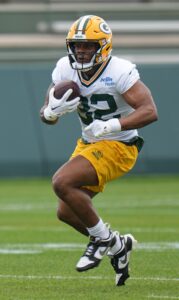 The Pack made Cooper this year’s first off-ball linebacker chosen, after seeing him become a first-team All-American in 2023. Showing tremendous promise as a blitzer, Cooper tallied eight sacks and 17 tackles for loss last season. It would surprise if he was not challenging for a starting role soon. A Florida transfer, Hopper followed Mizzou LBs Nick Bolton and Sean Weatherspoon as a Butkus Award finalist. After the Pack went from 2007-21 without choosing a non-rush ‘backer in the first three rounds, the Walker-Cooper-Hopper tandem gives them plenty of options over the next few years.
The Pack made Cooper this year’s first off-ball linebacker chosen, after seeing him become a first-team All-American in 2023. Showing tremendous promise as a blitzer, Cooper tallied eight sacks and 17 tackles for loss last season. It would surprise if he was not challenging for a starting role soon. A Florida transfer, Hopper followed Mizzou LBs Nick Bolton and Sean Weatherspoon as a Butkus Award finalist. After the Pack went from 2007-21 without choosing a non-rush ‘backer in the first three rounds, the Walker-Cooper-Hopper tandem gives them plenty of options over the next few years.
The third running back chosen, Lloyd joins a currently crowded backfield. His arrival probably makes this Dillon’s final Packers season. The Giants and Cowboys had the USC product on their radars; either having selected him would have made a path to a starting lineup clearer.
With Jacobs in the fold for at least two seasons, the Packers added a cheap supplementary option behind a $12MM-per-year player. Lloyd transferred from South Carolina to USC in 2023, totaling a career-high 820 rushing yards (7.1 per carry) last season. He tallied nine rushing touchdowns with the Gamecocks in 2022. Potentially a long-term threat to Jacobs, Lloyd may be a short-term IR candidate due to a hamstring injury.
Other:
- Named Ed Policy as Mark Murphy‘s successor as team president
- Fired defensive coordinator Joe Barry; hired Jeff Hafley as defensive coordinator
- Hired Derrick Ansley as defensive pass-game coordinator, Sean Mannion as offensive assistant
- Declined CB Eric Stokes‘ $12.47MM fifth-year option
- Signed eight UDFAs
 For the first time in 16 years, the Packers will use a 4-3 look as their primary base defense. That will add clarity to Lukas Van Ness‘ position, as the 2023 first-round ‘tweener now plays defensive end. This change comes about because the Packers dipped into the college ranks to find their next DC. After attempting to give the job to former Wisconsin DC Jim Leonhard three years ago, the team handed the reins to Barry. A rough regular season that included a 27th-place defensive DVOA finish — featuring Baker Mayfield carving up Barry’s defense and Tommy DeVito excelling on a nationally televised stage — prompted the Packers to cut bait and went off the board with their next hire. Barry landed as the Dolphins’ LBs coach.
For the first time in 16 years, the Packers will use a 4-3 look as their primary base defense. That will add clarity to Lukas Van Ness‘ position, as the 2023 first-round ‘tweener now plays defensive end. This change comes about because the Packers dipped into the college ranks to find their next DC. After attempting to give the job to former Wisconsin DC Jim Leonhard three years ago, the team handed the reins to Barry. A rough regular season that included a 27th-place defensive DVOA finish — featuring Baker Mayfield carving up Barry’s defense and Tommy DeVito excelling on a nationally televised stage — prompted the Packers to cut bait and went off the board with their next hire. Barry landed as the Dolphins’ LBs coach.
Tasked with maximizing the talent on the Packers’ first-rounder-laden defense, Hafley comes over from Boston College. The recent ACC leader did not mince words about the NCAA’s chaotic landscape pushing him back to the pros, and he did well to land a job with the only team that interviewed him. Hafley, 45, and LaFleur both coached under Kyle Shanahan; though, they were never on the same staff. Hafley worked with Shanahan in Cleveland (2014) and San Francisco (2017-18), serving as a DBs coach each time. He spent the past four seasons as Boston College’s HC, a gig Bill O’Brien now holds.
A mediocre Power 5 program, BC ranked 86th and 100th in scoring defense over the past two seasons. While the Eagles’ defense did place 31st in 2021, Hafley may not have been LaFleur’s first choice. The Packers announced the Hafley hire on January 31, the same day they interviewed Zach Orr. Green Bay was believed to have offered Orr the job, but with a path upward in Baltimore (he took the Ravens’ gig the following day), Orr stayed put. Hafley and LaFleur’s friendship aside, this is an interesting footnote as the two begin working together.
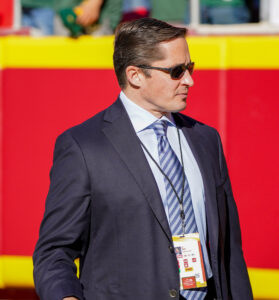 With no owner in place due to the Packers’ unique arrangement with Green Bay, this presidential role brings the most power of any across the league. The bylaws governing the Packers’ board of directors dictate that members must retire upon turning 70, which will be the case for Murphy on July 13, 2025. Murphy has served as Packers president since 2007, presiding over the awkward Brett Favre-to-Aaron Rodgers transition and then the 2021 standoff with Rodgers. Murphy signed off on the 2020 Love trade-up and the 2023 Rodgers trade and will continue in his role for one more season.
With no owner in place due to the Packers’ unique arrangement with Green Bay, this presidential role brings the most power of any across the league. The bylaws governing the Packers’ board of directors dictate that members must retire upon turning 70, which will be the case for Murphy on July 13, 2025. Murphy has served as Packers president since 2007, presiding over the awkward Brett Favre-to-Aaron Rodgers transition and then the 2021 standoff with Rodgers. Murphy signed off on the 2020 Love trade-up and the 2023 Rodgers trade and will continue in his role for one more season.
The son of former Super Bowl-winning 49ers exec Carmen Policy, Ed has been with the Packers since 2012. The 53-year-old staffer currently serves as the team’s COO and general counsel, and he won a pursuit that included as many as 90 potential candidates. That list, which included Commanders president Jason Wright, winnowed to 10 by Memorial Day. Formerly the Arena Football League president, Policy will soon step into a coveted role.
After losing much of the past two seasons to injury, Stokes is near the finish line of a journey back to the Pack’s starting lineup. Knee and foot surgeries, after going down midway through the 2022 season, affected Stokes’ 2023. The former first-rounder attributed his run of hamstring issues — which capped his ’23 season at three games — to overcompensation following his foot issue. After trading Rasul Douglas to the Bills, the Packers did not draft a corner until Round 7. Stokes, who showed promise in his rookie season, clocked two sub-4.3-second 40 times at his 2021 pro day and has a chance to regain value ahead of what could be an interesting free agency next year.
Top 10 cap charges for 2024:
- Kenny Clark, DT: $26.37MM
- Jaire Alexander, CB: $23.49MM
- Jordan Love, QB: $20.76MM
- Elgton Jenkins, G: $14.5MM
- Preston Smith, DE: $14.12MM
- Rashan Gary, DE: $11.15MM
- Xavier McKinney, S: $7.8MM
- Josh Jacobs, RB: $5.31MM
- Keisean Nixon, S: $3.99MM
- Lukas Van Ness, DE: $3.95MM
Losing Bakhtiari, the Packers have just one player (Preston Smith) north of 30. This young roster has received more buzz ahead of Love’s second season, and the team will attempt to catch up to the soaring Lions — as the Bears maneuvered their way to Caleb Williams. The Lions’ roster talent and the Bears having restarted their QB contract clock notwithstanding, it will be difficult to foresee the Packers not being a contender this season.
More pressure will be applied to Love, of course, thanks to the monster extension he secured with far less game experience compared to just about every modern QB given a big-ticket deal. The Packers, however, return their top four wide receivers — with the group’s mysterious hierarchy set to bedevil fantasy GMs — and added Morgan to a promising O-line returning its other four starters.
Green Bay’s latest unorthodox QB approach skipped the rookie-contract shortcut other burgeoning Super Bowl threats have capitalized on during the rookie-scale era, but the team being right on Love will minimize that oft-discussed component. Love delivering on this contract would begin an unfathomable QB stretch for this franchise, as the intriguing starter is the gateway to a reality in which the Packers enjoy 40-plus years of stability at the game’s centerpiece position.
The “maximize the rookie window” analytics crowd stems back to Russell Wilson’s success in his first contract with the Seahawks. That defense was legendary. It’s at least as hard to have a top 5 defense for several years in a row as it is to find a franchise QB. The Packers have had the right process with QBs. Let them sit and learn. Start them in year one and the bust potential is much higher.
And this Packers team? It’s a juggernaut. They were better than the Lions the last half of last season. They beat the Chiefs. And they had the 9ers on the ropes. All while being the youngest team in the NFL. They only got better this offseason.
It’s shaping up to be a special season in Titletown. This feels an awful lot like 2010. Most Packers fans expect to win the division and make a deep playoff run, with Super Bowl glory a distinct possibility.
Could they complete for the NFC title? Maybe. They need to put together a full season, then we’ll see. They had a deep draft and still have a young team. I like the Josh Jacobs pickup.
juggernaut? mix in a water buddy
we’ll see…
Solid 11 win team
Gonna be hard for the Packers to win those drama awards now that Rodgers has left.
The Packers need to be in the backup QB market. The folks they currently have on the roster have no talent whatsoever.
Shhh! There are people who swear Clifford is a future HOF’er and should be the starter.
Clifford has been bad. But if your biggest problems are Kicker, backup QB and OL depth, you’re doing ok…